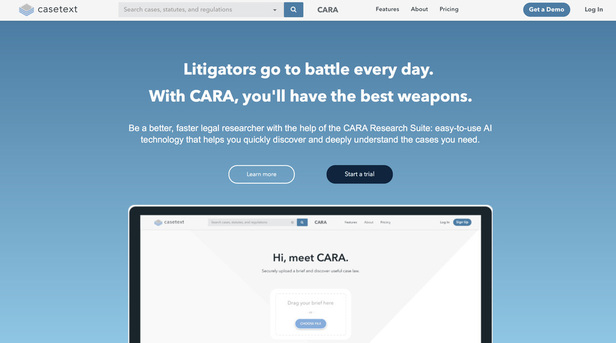Casetext Launches 'Push Research' Feature for Litigators
Casetext, the Silicon Valley-based automated legal research company, is piloting a new feature that will push data to litigators about their cases as soon as new filings hit the docket, according to a company co-founder.
October 20, 2017 at 02:28 PM
14 minute read
 Casetext website.
Casetext website. SAN FRANCISCO — Casetext, the Silicon Valley-based automated legal research company, is piloting a new feature that will push data to litigators about their cases as soon as new filings hit the docket, according to a company co-founder.
Casetext's existing platform, called CARA (Case Analysis Research Assistant), already allows users to drag-and-drop court filings to find relevant decisions or case briefs. The new feature “listens” to dockets that litigators select and sends them relevant information automatically.
For example, if a motion for summary judgment is filed, Casetext's new push feature automatically analyzes it and sends an email to the opposing litigator with information about relevant cases not mentioned in the brief that might help argue against the motion.
“It's a new way of looking at legal research,” Pablo Arredondo, co-founder and chief legal research officer at Casetext, said in an interview Thursday. Eight law firms are currently testing the feature, Arredondo added, including Quinn Emanuel Urquhart & Sullivan, Ogletree Deakins, and Fenwick & West.
Arredondo said the tool uses language cues in the docket to make sure litigators only get those push alerts for relevant briefs—and not, for example, after a notice of appearance. “We have sort of a multilayered approach to make sure it's only substantive filings,” he said.
Casetext started piloting the feature in early October. The release comes just months after the company launched an AI “brief finder” feature in May, which helps lawyers find similar cases to the one they are working on and the briefs submitted for those cases.
 Casetext website.
Casetext website. SAN FRANCISCO — Casetext, the Silicon Valley-based automated legal research company, is piloting a new feature that will push data to litigators about their cases as soon as new filings hit the docket, according to a company co-founder.
Casetext's existing platform, called CARA (Case Analysis Research Assistant), already allows users to drag-and-drop court filings to find relevant decisions or case briefs. The new feature “listens” to dockets that litigators select and sends them relevant information automatically.
For example, if a motion for summary judgment is filed, Casetext's new push feature automatically analyzes it and sends an email to the opposing litigator with information about relevant cases not mentioned in the brief that might help argue against the motion.
“It's a new way of looking at legal research,” Pablo Arredondo, co-founder and chief legal research officer at Casetext, said in an interview Thursday. Eight law firms are currently testing the feature, Arredondo added, including
Arredondo said the tool uses language cues in the docket to make sure litigators only get those push alerts for relevant briefs—and not, for example, after a notice of appearance. “We have sort of a multilayered approach to make sure it's only substantive filings,” he said.
Casetext started piloting the feature in early October. The release comes just months after the company launched an AI “brief finder” feature in May, which helps lawyers find similar cases to the one they are working on and the briefs submitted for those cases.
This content has been archived. It is available through our partners, LexisNexis® and Bloomberg Law.
To view this content, please continue to their sites.
Not a Lexis Subscriber?
Subscribe Now
Not a Bloomberg Law Subscriber?
Subscribe Now
NOT FOR REPRINT
© 2025 ALM Global, LLC, All Rights Reserved. Request academic re-use from www.copyright.com. All other uses, submit a request to [email protected]. For more information visit Asset & Logo Licensing.
You Might Like
View All
Morgan Lewis Shutters Shenzhen Office Less Than Two Years After Launch

Invoking Trump, AG Bonta Reminds Lawyers of Duties to Noncitizens in Plea Dealing
4 minute read
‘Extremely Disturbing’: AI Firms Face Class Action by ‘Taskers’ Exposed to Traumatic Content
5 minute read
State Appeals Court Revives BraunHagey Lawsuit Alleging $4.2M Unlawful Wire to China
3 minute readTrending Stories
- 1'A Death Sentence for TikTok'?: Litigators and Experts Weigh Impact of Potential Ban on Creators and Data Privacy
- 2Bribery Case Against Former Lt. Gov. Brian Benjamin Is Dropped
- 3‘Extremely Disturbing’: AI Firms Face Class Action by ‘Taskers’ Exposed to Traumatic Content
- 4State Appeals Court Revives BraunHagey Lawsuit Alleging $4.2M Unlawful Wire to China
- 5Invoking Trump, AG Bonta Reminds Lawyers of Duties to Noncitizens in Plea Dealing
Who Got The Work
J. Brugh Lower of Gibbons has entered an appearance for industrial equipment supplier Devco Corporation in a pending trademark infringement lawsuit. The suit, accusing the defendant of selling knock-off Graco products, was filed Dec. 18 in New Jersey District Court by Rivkin Radler on behalf of Graco Inc. and Graco Minnesota. The case, assigned to U.S. District Judge Zahid N. Quraishi, is 3:24-cv-11294, Graco Inc. et al v. Devco Corporation.
Who Got The Work
Rebecca Maller-Stein and Kent A. Yalowitz of Arnold & Porter Kaye Scholer have entered their appearances for Hanaco Venture Capital and its executives, Lior Prosor and David Frankel, in a pending securities lawsuit. The action, filed on Dec. 24 in New York Southern District Court by Zell, Aron & Co. on behalf of Goldeneye Advisors, accuses the defendants of negligently and fraudulently managing the plaintiff's $1 million investment. The case, assigned to U.S. District Judge Vernon S. Broderick, is 1:24-cv-09918, Goldeneye Advisors, LLC v. Hanaco Venture Capital, Ltd. et al.
Who Got The Work
Attorneys from A&O Shearman has stepped in as defense counsel for Toronto-Dominion Bank and other defendants in a pending securities class action. The suit, filed Dec. 11 in New York Southern District Court by Bleichmar Fonti & Auld, accuses the defendants of concealing the bank's 'pervasive' deficiencies in regards to its compliance with the Bank Secrecy Act and the quality of its anti-money laundering controls. The case, assigned to U.S. District Judge Arun Subramanian, is 1:24-cv-09445, Gonzalez v. The Toronto-Dominion Bank et al.
Who Got The Work
Crown Castle International, a Pennsylvania company providing shared communications infrastructure, has turned to Luke D. Wolf of Gordon Rees Scully Mansukhani to fend off a pending breach-of-contract lawsuit. The court action, filed Nov. 25 in Michigan Eastern District Court by Hooper Hathaway PC on behalf of The Town Residences LLC, accuses Crown Castle of failing to transfer approximately $30,000 in utility payments from T-Mobile in breach of a roof-top lease and assignment agreement. The case, assigned to U.S. District Judge Susan K. Declercq, is 2:24-cv-13131, The Town Residences LLC v. T-Mobile US, Inc. et al.
Who Got The Work
Wilfred P. Coronato and Daniel M. Schwartz of McCarter & English have stepped in as defense counsel to Electrolux Home Products Inc. in a pending product liability lawsuit. The court action, filed Nov. 26 in New York Eastern District Court by Poulos Lopiccolo PC and Nagel Rice LLP on behalf of David Stern, alleges that the defendant's refrigerators’ drawers and shelving repeatedly break and fall apart within months after purchase. The case, assigned to U.S. District Judge Joan M. Azrack, is 2:24-cv-08204, Stern v. Electrolux Home Products, Inc.
Featured Firms
Law Offices of Gary Martin Hays & Associates, P.C.
(470) 294-1674
Law Offices of Mark E. Salomone
(857) 444-6468
Smith & Hassler
(713) 739-1250






